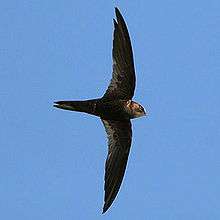African black swift
| African black swift | |
|---|---|
 | |
| Scientific classification | |
| Kingdom: | Animalia |
| Phylum: | Chordata |
| Class: | Aves |
| Order: | Apodiformes |
| Family: | Apodidae |
| Genus: | Apus |
| Species: | A. barbatus |
| Binomial name | |
| Apus barbatus (Sclater, 1866) | |
The African black swift or African swift (Apus barbatus) is a small bird in the swift family. It breeds in Africa discontinuously from Liberia, Cameroon, Zaire, Uganda and Kenya south to South Africa, and on Madagascar. The breeding habitat is damp mountains, typically between 1,600 - 2,400 m, but less often at lower altitudes. This species feeds readily over lowland, and can form very large flocks, often with other gregarious swifts.
_in_flight%2C_above_and_side_view.jpg)
The nominate South African subspecies is migratory, wintering further north. Other subspecies are resident. Of the other seven accepted forms, the most widespread is the small dark A. b. roehli of east Africa. Two other dark races, A. b. balstoni and A. b. mayottensis, are restricted to Madagascar and the Comoro Islands respectively. It has been suggested that some balstoni migrate to the continental mainland when not breeding, but this has not been proved.
East African birds nest in hollow trees, whereas in South Africa this species uses cliffs, usually inland but also on the coast. The African black swift is a colonial breeder, sometimes forming mixed colonies with alpine swifts. The nest is a shallow grass cup glued to the substrate with saliva, and the typical clutch is one or two eggs.
The African black swift is 16–18 cm long and bulky like a pallid swift; it appears entirely blackish-brown except for a small white or pale grey patch on the chin which is not visible from a distance. It has a short forked tail and very long swept-back wings that resemble a crescent or a boomerang. This species is very similar to common swift but can be distinguished under optimum viewing conditions by the contrast between its black back and paler secondary wing feathers. The heavier build also gives it a distinctive flight action, which consisted of a steady level flight interspersed with short glides.
The call is a loud double rasped hissing scream zzzzzzzZZZTT, dissimilar to that of its confusion species.
References
- ↑ BirdLife International (2013). "Apus barbatus". IUCN Red List of Threatened Species. Version 2013.2. International Union for Conservation of Nature. Retrieved 26 November 2013.
| Wikimedia Commons has media related to Apus barbatus. |
- Chantler and Driessens, Swifts ISBN 1-873403-83-6
- Sinclair, Hockey and Tarboton, SASOL Birds of Southern Africa, ISBN 1-86872-721-1
External links
- African black swift - Species text in The Atlas of Southern African Birds.
